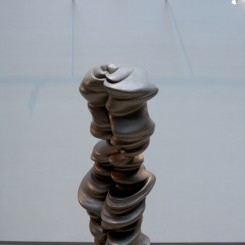“Tony Cragg: Sculptures and Drawings”
Shanghai Zendai Himalays Art Museum (3F No. 869 Yinghua Road, Pudong District, Shanghai) Sep 8 – Nov 11, 2012
Tony Cragg has arrived in Shanghai, and the newly reopened Shanghai Zendai Himalayas Art Museum hopes that this well-renowned sculpturist will set a tone of professionalism and credibility to their tentative future. For the most part, they have handled this quasi-retrospective with the appropriate reverence and attention to detail an artist like Cragg deserves.
After your entry fee has been collected into an open shoebox by a dozing teenager, one is presented with a daunting space punctuated by works from 1970 to 2010. Gears and other industrial detritus are stacked heavily into mighty cones; nearby, a table and chair are completely covered in wooden knobs. Moving further into the museum, one can appreciate the cathedral-like height of its ceiling, which dwarfs even Cragg’s imposing pieces. The main area is populated by some classic Craggian forms — lumbering, smooth masses that seem to float despite their apparent tonnage. These multi-layered, stacked works are reminiscent of totem poles, yet they resemble no bestial figure and hold no tales.
A few rooms lead off the main area, where low lighting and relatively claustrophobic ceilings thrust visitors into more intimate relations with particular sets of sculptures. Natural, looping forms are complicated by a closer inspection which reveals a series of what appear to be meaningless letters and numbers. Another chamber displays a series of Cragg’s drawings — meditations in charcoal and pen on the nature of his work that range from apparent conceptualizations of sculptures he would later create to beautiful renditions of what seems to be a smelting factory. Coupled with the sculptures themselves, these drawings allow one particular proximity to the artist’s process. While the drawing rooms felt aesthetically disparate from the rest of the exhibition, they were a wise and worthwhile inclusion.
In sum, the show was consciously laid out, well lit, and poorly labeled (some sort of map would have been very helpful). Zendai’s unique space worked relatively well for this exhibition, but could serve to its detriment for future artists who don’t traffic in large sculptures. Fans of Cragg’s work will not be disappointed by the breadth and depth of the work on display.
